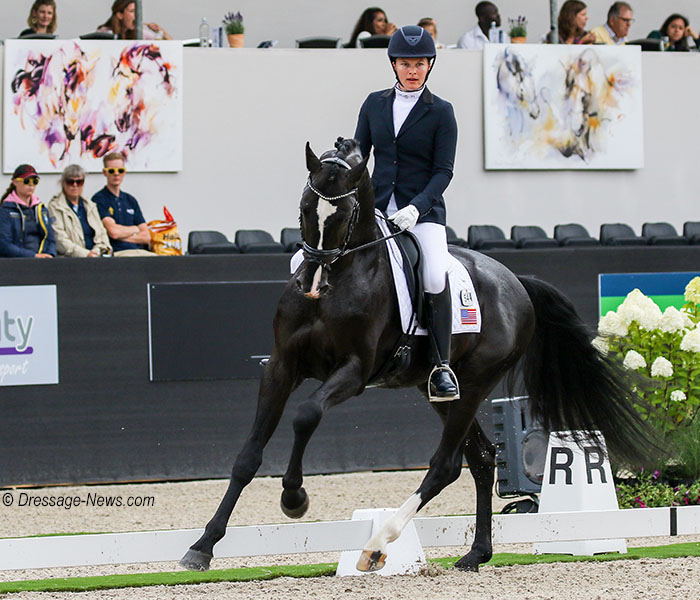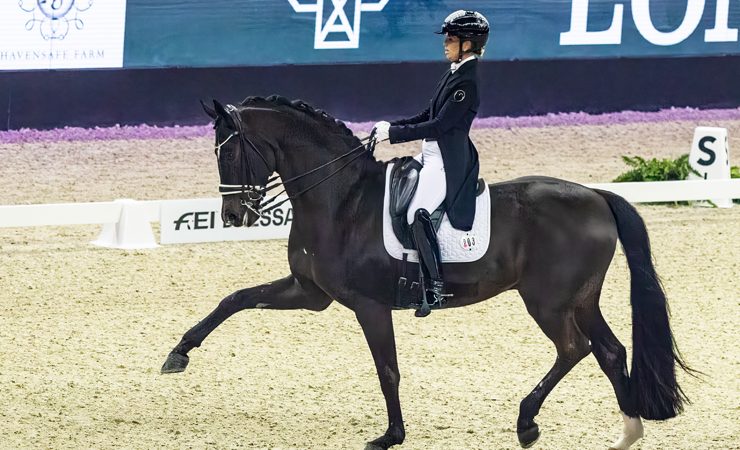Emily Miles on World & US Young Horse Championships a Decade Apart
5 years ago StraightArrow Comments Off on Emily Miles on World & US Young Horse Championships a Decade Apart

Aug. 21, 2019
By KENNETH J. BRADDICK
Fresh from her second World Young Horse Championships in a decade, Emily Miles is at the United States championships this week with questions about developing horses for competition.
“The caliber of horses is brilliant,” she said after competing two stallions in the world five-year-old championships. “We’re breeding such talented horses. I think both times I’ve been very impressed with the quality of horses and both times, whoa! We have a lot to learn.”
Emily competed the stallions Sole Mio, a Rhinelander, and Daily Show, a Hanoverian, in the preliminary five-year-old division. Both are owned by Leslie Waterman who has other horses with Emily. She is scheduled to compete Sole Mio at the American championships in Wayne, Illinois this week.
Emily had her first major success in 2010 with Wakeup, a black stallion bred and trained at home in La Cygne, Kansas–more than a 1,000 miles from the centers of dressage in Florida and Southern California–that she competed at the world championships.
“The last time,” she recalled, “it was me and my horse that we bred.”
She and Wakeup (Wagnis x Macho) went to Hof Kasselmann’s in Hagen, Germany and worked with Ulf Möller, a leading young horse trainer who now works with Helgstrand Dressage whose business is based in Denmark but has a seasonal operation in Wellington, Florida.
“Ulf took me under his wing, did everything for me,” she said. “He put me into his funnel. It was like being starstruck the whole time. I only had myself and my horse to worry about.”
After the 2010 championships in Verden, Germany, Emily and Wakeup moved up in the sport–winning the 2011 national championships for six year olds a year later, Developing Prix St. Georges reserve champion in 2012 and capturing the title in 2013. Then Developing Grand Prix champion in 2014.
Wakeup’s Big Tour career has not been as successful. Maintaining him at the top level to compete in enough CDIs to become a team contender “gets a bit dicey,” she explained.
“Instead of riding him until he’s broken why don’t I let him retire, breeding and happy and owns the king’s stall in the barn,” she said. “He’s the first one I say ‘hi’ to in the morning. He’s still with us and always will be but as of now he’s retired from competition.”

Now 31 years old and married with a young son, Oliver, this time was “very different.”
“I had two horses and they’re not mine, they’re a client’s,” Emily said. “I was more on my own and had my son and my husband with me so a totally different situation.” But she had a groom this time.
Emily qualified for this year’s world championships for Sole Mio with scores that averaged 82.733% and Daily Show with an average of 85.033% at three shows in the Midwest in April and May this year.
For the championships, she located herself in Verden, Germany–the host city of the 2010 championships–for four weeks of training before transferring to Ermelo in the Netherlands. The auction horses were there but I wasn’t with another trainer.”
This time, “I think I saw it through a different lens. I’m more educated, I hope, nine years later. I remember coming back from the last one and being so inspired, thinking I need to do this again–so, like amazing. I thought all the horses were amazing.”
“I felt like last time I was very well prepared because I was with Ulf and that year Eva, his wife, had three horses in the top winning medals and I was surrounded by that every day for the month coming up to the final. I watched Eva every morning while Ulf taught her and all the other brilliant stallions they had that weren’t going to the world championships. I felt I was blessed to watch that caliber of riding all day long.”
The world championship results with Sole Mio were 74.800% in the first preliminary test and 80.000% in the small final, while Daily Show received 72.800% in preliminary and 76.200% in the small final. Neither made it to the final of 15 horses.
Emily said Sole Mio “did a really nice job” the first day but the biggest complaint from the judges was that he was not showing enough of his potential.
With Daily Show, “I ate my humbe pie for the day. I revved him up and thought, ‘let’s go for this.’ He got a super good trot but that kind of hurt us in the walk and the canter because of the tightness in the tension and got pretty puffed up.
“Then he got more puffed up in the ring, so that kind of back-fired on me. Live and learn, right. You don’t get better if you don’t expose yourself and put yourself out there.”
In the small final the following day she was happy with both.

“The fact they went in and did their job—the first day I went in there and I felt I didn’t belong here. Then I felt it’s OK. I have a lot to learn. they are good horses. They’re going to learn with me. I was so proud of them because they did what I told them to do. I think they are brilliant horses. I just have to learn how to ride them specifically for something like this better.”
But the results, Emily said, “raised questions about the fundamental differences between the U.S. and Europe. What do we lack in the U.S. and what is the fundamental diference. Is it because most of our market for dressage horses is adult amateurs? I don’t think that is so different over here. Is the culture of breeding over here so different?”
She told of being in Verden while a foal show was being prepared and 151 foals arrived.
“Where in the U.S. do you end up with 151 foals, well-bred Hanoverians, all in the one place on the same day?
“Is that something that is inherently different between our countries?”
Emily stresses she is not complaining, but raising questions.
“I felt when I qualified we needed to have judges and riders who come over here and see this so we know what is expected here. For example, I’ve had a test in the U.S. where the main knockdown was tension. I felt that I had a fraction of the amount of ‘pumped-upness,’ to use a nicer word, that some of the horses (in Ermelo) displayed. So I think we maybe have different visual ideas in our head of what is a truly spectacular five year-old, how does it go and what should it look like.
“I don’t want to say we’re wrong in the U.S. but I do think knowledge is power so we should observe more, our judges should observe more, our competitors, not only those who may want to come here, but our national competitors, our coaches and our trainers not just the national coach but in general young horse teachers or whatever should come over here and watch this because it’s different.”

Views about performances of some young horses were expressed by some of the international media as watching “five-year-old Grand Prix horses,” exhibiting gaits such as extended trot that is not in the test but not dealt with by judges. And some longtime journalists knowledgeable about young horses were not in attendance for other reasons, such as perceived domination by one entity.
Emily makes a point that has been echoed by some other Americans over the years.
The championships, she notes, are “hugely expensive and to not even get into the final begs the question whether you could spend the money on something better.
“While I love the show it’s a huge inspiration to be out there with amazing riders, you have to be realistic. Would we do this again next year? Right now I would say ‘no.’ Would we want them to try for six-year-old in the U.S.? ‘Yes.’ I would want them to continue their careers and that’s the biggest thing in the U.S. for them.”

